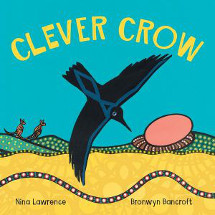Clever crow by Nina Lawrence

Ill. by Bronwyn Bancroft, Magabala Books, 2018. ISBN 9781922142610
(Age: 4+) Highly recommended. Themes: Aboriginal themes. Crows.
Cleverness. Language. Crow flies around the countryside looking for
food, he is hungry and no matter how far he searches, he cannot find
anything to eat. He spies several young men preparing for a
ceremony, while their mother fans a fire ready to cook a turtle egg.
Crow spies the egg and swoops down to grab it in his beak. But other
animals are cleverer than he. Kookaburra laughs, making crow laugh
and the egg drops from his beak. It rolls into the waiting pouch of
a wallaby, but when she goes to rest in the shade, it rolls out of
her pouch and onto the riverbank. Nearby an old man is fishing and
spies the egg, taking it onto his boat. He knows someone will be
happy to eat this egg, and finds several young men and their mother
on the riverbank preparing for a ceremony, the perfect recipients
for the egg. But crow is still watching, and when the egg is handed
over he swoops, taking the egg back again and flying off with his
prize.
A delightfully funny and rounded story of being clever, crow will
make readers laugh as they watch his antics at getting food for his
empty stomach. The stunning illustrations complement the story, with
their bold, black outlines and techniques reflecting dot paintings.
Award winning illustrator, Bronwyn Bancroft, a Djanbun clan member,
brings her vast experience to the story, adding levels of interest
to the story of the crow which will engage and delight younger
readers. In telling the story of crow, Nina Lawrence, from the
Yidinji of Far North Queensland, reflects the community of her
childhood and the stories she heard of survival in the bush.
The book has parallel texts, of English and Yolngu of Arnhem Land and
the latter seems almost woven into the illustrations as it follows
the repeated band of colour and dots across the bottom of each page,
drawing the eye to the unfamiliar words, which are given in
translation in a glossary at the end of the book.
This book gives so much more than the simple story told. Children
will talk about the ceremony and what the boys are doing, they will
ask questions about their mother building a fire, and the food that
people eat and how it is collected, they will wonder at the things
the people are doing. Each page will produce questions from the
listeners and I can imagine many students trying out Bancroft's
illustrative style as well as speaking the language for themselves.
Fran Knight